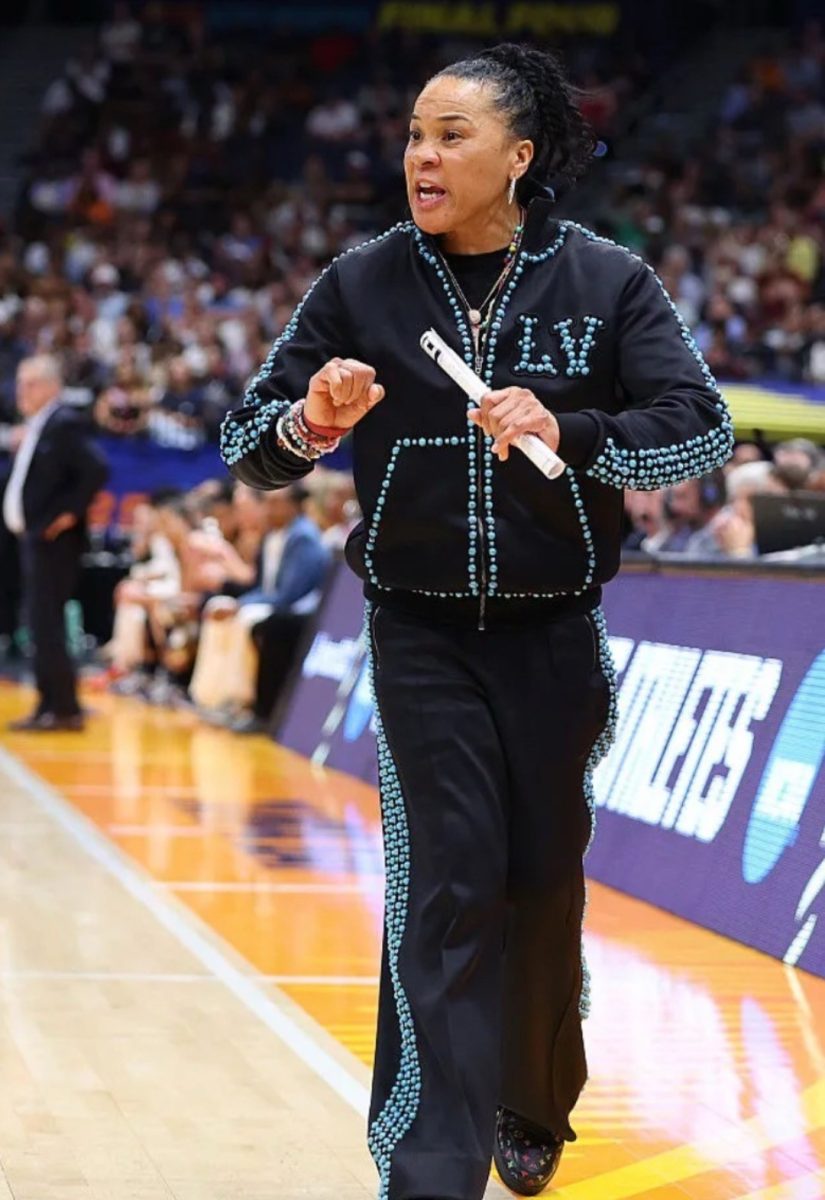As a student athlete, I firmly prioritize my mental and physical health. I know that without doing so, I would not be able to perform athletically to the best of my ability. I always take steps to keep myself under control- this means listening to both my body and my mind, and making decisions for myself that will benefit both of them.
I have always been aware of the commitment that comes with being a student athlete. It takes time and effort: more time and effort than the average student could spare.
I sometimes think about how much less stressful my life would be if I did not actively participate in sports throughout the busy school year. I could go home, nap to reset my brain, and then I’d have the rest of the evening to do schoolwork. Instead, after a seven hour school day followed by a two hour practice, I am often too exhausted to put maximum effort into my schoolwork. This almost always leads to procrastination, and therefore additional stress.
With interest in researching if this was a common sentiment among other student athletes, I decided to look into mental health in student athletes.
The National Library of Medicine conducted a survey in 2023 to understand the stress levels among high school athletes, their coping mechanisms, and their willingness to seek help. The survey was conducted online with 200 participants, aged 16-17.
About 91% of the respondents claimed to experience stress due to sports, with the most common causes of stress being fear of failure and self-pressure.
Notably, 34% reported that their stress positively impacted their performance. The majority resorted to exercise as a coping mechanism, while 50% would first approach friends for help. About 27% experiencing moderate to extreme stress desired but did not seek help from medical professionals.
The study efficiently highlighted the need to address stress that high school athletes endure, considering the potential long-term impact on mental health. The NIH advocates for increased accessibility to mental health resources, reducing stigmas, and fostering a supportive environment for athletes: something the athletic community seems to lack.
Student athletes everywhere share common sentiments about mental health, but there aren’t many who have taken steps to make changes to their school’s athletic department. There is nothing wrong with this, considering it takes a lot to brave the judgment that often comes from speaking out.
It only takes one voice to make a change.
Jack Dahler, a high school tennis player in 2022, knew this very well.
It all began when Dahler suffered a debilitating back injury, leading to hospitalization. A future he once saw in tennis was gone in his eyes. Three long weeks of not being able to walk independently followed his surgery. While he suffered physically, he also suffered mentally in not being able to play the sport he loved.
Feeling isolated and hopeless, he decided he was going to do something about his mental health battle. Dahler launched a website called “Out of Bounds,” which served as an outlet and resource for teen athletes facing similar challenges.
He aimed to break the stigma surrounding mental health in sports and create a place where young athletes could feel supported in sharing struggles and connecting with each other. The website was extremely successful and became a safe space for many student athletes.
“They think they can’t talk to anybody about it. They’re scared to talk to people about it. They’re embarrassed that they’re not tough. But frankly, being tough is talking to people about it. That is tough. That is courage,” Dahler proclaimed in an interview.
Following his creation, his own healing journey progressed. His depression began to subside and he took back his physical state and place on the court, eventually becoming the team captain.
Jack’s story is not meant to say that in order for progress to be made, you have to take dramatic action, but rather to say that speaking out at any capacity is okay. Is it difficult, and easier said than done? Yes. But it is also clear, based on statistics, that no student athlete is alone in their mental health struggles. The only way to connect and feel supported is to talk about it.
The sad part is that a lot of the time we don’t give mental health the proper attention until it’s too late. In 2018, at Redmond High School in Oregon, a wakeup call was received when a three-sport athlete took their own life. Immediately after it happened their athletic program began taking steps to reevaluate everything and ensure that it would not happen again.
Since then, Redmond has made sure to check in on the moods and personal lives of student athletes, performing routine mental health checks and hiring dedicated counselors. Despite these precautions taken, the school has made it clear that given the number of athletes in the program, they will never come close to meeting the needs of every student or knowing the extent of their mental struggles.
At the Redmond School District’s monthly coaches meetings, Student-Athlete Development (SAD) is focused on. This includes Mental Skills Training, Emotional/Mental Health, Physical Improvement, and Academic Responsibility and Success: the four key areas.
Redmond High School has placed emphasis on their awareness, intervention, and community resources throughout the years in order to create an environment where no student athlete falls through the cracks.
Redmond’s initiative is extremely commendable, especially considering that the majority of high schools do not pay much attention to the mental health of student athletes.
However, it is disheartening to think about how it took a suicide for the district to care.
The saying goes, “better late than never”… but at what cost?
I conducted my own survey with 65 participants, students, and student athletes.
Regarding mental health, 42.9% of student athletes consider theirs to be either below average or poor. Meanwhile, 48.2% of non-student athletes consider it either below average or poor. These statistics show a significant percentage of students with low mental health, yet the mental health of student athletes seems to be better.
Both groups experience high levels of stress due to daily activities, with student athletes at 72.2% and non-student athletes at 72%. Non-student athletes are only slightly more probable to experience stress, with nobody in this category never feeling stressed.
Academic pressures are the predominant source of stress for student athletes, constituting 52.8% of their reported stress. In contrast, non-student athletes face stress primarily from social expectations (37.9%) and academic pressures (34.5%).
A finding deemed concerning is that a significant portion of student athletes (60%) and non-student athletes (69%) have noticed a decline in their mental health. Additionally, the majority in both groups report no improvement.
A notable difference exists in seeking help for mental health. While 33.3% of student athletes have been treated, 55.6% have not sought help. On the other hand, a higher percentage of non-student athletes (72.4%) have either received or considered treatment.
Despite the challenges of being a student athlete, the majority of them (55%) agree that participating in a sport has positively impacted their mental health. Among previous student athletes, a significant percentage (26.3%) also acknowledges positive effects, and a large portion (57.9%) remains neutral.
The statistics shocked me to say the least. I had always assumed that because student athletes have a lot more on their plates than non-student athletes, they’d be more stressed, therefore having worse mental health. However, the results contradicted my take.
While both groups are often stressed, the mental health of non-student athletes is reported to be worse. Non-student athletes face more mental health declines than student athletes, and are also much more likely to seek help.
The majority of student athletes claim that participating in a sport positively impacts their mental health, but they face more pressure than regular students when it comes to academics.
After having some conversations about the statistics with my friends, we came to the conclusion that student athletes generally have better mental health because they have an incentive to get up and move around. A lot of them -whether it is intentional or not- probably use their sport as a means of distraction and escape.
Non-student athletes have a lot more time to focus on their school work, which is why the noted academic pressure stress levels are lower. Alternatively, the stress from social pressures is just as high, which could mean that non-student athletes may have a harder time socializing with people or fitting in.
And given the stigma surrounding the mental health of athletes, it is not entirely shocking that they are less likely to seek help. In addition to that, athletes might also not have as much time to seek help, or even think about their mental health.
To better understand the feelings of student athletes, I sent out another survey directed specifically towards them. This one had 21 participants.
66.7% of student athletes agreed that the time commitment required for their sport affects their ability to manage academic responsibilities. 57.1% agreed that balancing academics and athletics is a challenging aspect of their life. 100% claimed that they have experienced burnout or exhaustion from the demands of both academics and athletics.
The data was almost evenly split when athletes were asked if they saw a positive change in their time management skills. 52.4% said yes, while 47.6% said no.
On the flip side, 76.2% agreed that their participation in sports contributes to their overall well-being. 95.2% feel a sense of accomplishment after a successful athletic performance. 90.5% agree that their sport has taught them valuable life skills, like discipline and teamwork. 71.4% agree that participating in athletics has contributed to their confidence.
So, despite the academic pressure, the majority of student athletes seem to experience positive attributes from participating in sports. It would be ignorant of me to say that this survey did not have any limitations, given the nonexistence of a “neutral” option, and the fact that each individual athlete has their own complex views and experiences.
While academics are a big stressor for athletes, a large factor of whether or not they enjoy sports is the team experience. 45% of student athletes reported having a team environment that negatively impacted their mental health, and 90.4% agree that having supportive teammates is essential for their enjoyment of sports.
This is its own problem, drawing the conclusion that a good amount of student athletes do not have supportive teammates and coaches, which circles back to the stigma surrounding mental health being the reason athletes do not feel comfortable speaking out. Feeling unsupported on a sports team likely hinders the comfort with speaking out, leading to suppression.
My survey results back up Jack Dahler’s objective in creating his website. Support in athletic communities is crucial yet nonexistent most of the time. If it wasn’t for proactive people like Jack, more students would unfortunately end up like the three-sport athlete from Redmond.
95.7% of athletes who took my second survey agreed that mental health needs to be more focused on in the athletic community, with 76.2% of them currently feeling unsupported.
I asked coaches from Eastern about their perspective on mental health.
It seems that coaches try to stress mutual support and empowerment. One coach expressed, “We emphasize the family culture. That we are here to help and support each other. We empower the players to help each other.”
Recognizing stress in players is intuitive, and comes from getting to know the players and observing body language. It is also easy to tell if a player is not doing well if they are not performing at their best.
Tom Armour, the volleyball coach, proclaimed, “Stress is a part of athletics.” He made it clear that he goes through his own setbacks, and tries to show his athletes that setbacks are a part of the sport, and life in general. Body language is an indicator of stress for him as well.
Jeana Ritchie, the boys track and field coach, fosters resilience as she incorporates low-stress days and nature walks into the practice schedule. “I try to instill upon my athletes that one race does not define you as a person or track athlete.”
In boys and girls tennis, George Kemery prioritizes personal health: “My expectations for performance are third to personal health, then grades.”
Every coach that offered their perspective agreed that communication with both athletes and parents is necessary in order to instill a positive environment and recognize when an athlete is struggling. It is clear that the coaches at Eastern value their players. However, it is unrealistic for them to “fix” their athletes when they see mental struggles.
They do their best to help, but to fix the mental health crisis among athletes is to fix the athletic program, where students feel unsupported despite the support that coaches try their best to provide.
All of the information (The NIH research survey, Jack Dahler’s stand for mental health, Redmond High School’s incident, my surveys) connects and circles back to the central issue- stigma.
In the world of student athletics, the balance between mental and physical health becomes a factor in the strive for excellence. As a student athlete, recognizing this is crucial.
My journey provides a deeper look into the stressors faced by student athletes and the often-overlooked impact on their mental well-being.
The stories of coaches emphasizing mutual support, resilience-building, and the acknowledgment of setbacks reveal a collective dedication to fostering a positive environment. However, the concerning statistics regarding mental health display a significant gap in support. It prompts a crucial call to action for schools and athletic programs to break the chains of stigma, instigate open conversations, and prioritize mental health resources.
As students, athletes, and individuals, we must collectively raise our voices, challenging the status quo and building a supportive community where mental health is acknowledged, discussed, and nurtured.
We need to find a way to strive for a change in underlying assumptions and foster a culture where every athlete feels seen, supported, and empowered to prioritize their mental well-being.








